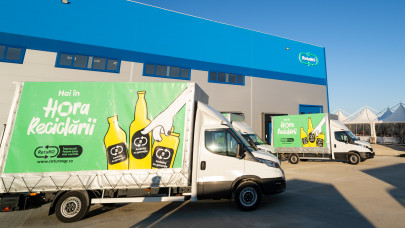What are the biggest challenges you have faced as a minister?
At the Ministry of Environment, Water and Forests, priorities and challenges change from day to day, depending on events and issues, because they can be emergencies related to severe weather, pollution, climate change, forests, or water.
Whenever I talk to my colleagues from the departments of the ministry, whether I talk to those from Climate Change, Biodiversity, or Pollution Control or that I talk to from Waste, Forests, from Water, every hour, if not every minute, a new problem appears that seems to be the ministry's zero priority, and from this point of view I have to be very careful when I choose certain topics of interest or when I consider certain things to be more important than others, because, in fact, I ask myself this question several times a day.
When you find that you have problems with the hydrotechnical installations, you realize that, at that moment, it is the most important thing for the ministry. When the National Weather Service gives me code red alerts, two in one week for the same area, I find that, in fact, the phenomenon of climate change should be managed as a priority. When we discuss forests, when we discuss waste, I always have the same feeling that we have to put everything else on hold and deal with certain issues. Just an absolute priority is the infringement proceedings, and I am thinking of the one that relates to the closure and greening of 101 municipal and industrial waste sites, some of them even hazardous waste.
So there is a lot to do at the ministry.
How many environmental infringements does Romania have now? How many did you solve?
Currently, 16 infringement proceedings are ongoing, of which 14 are in the pre-litigation phase and two are in the litigation phase.
Thus, in the field of waste management, there are three procedures: two in the pre-litigation phase and one in the contentious phase, aimed at implementation aspects (non-closure of some non-compliant waste deposits, which have expired the period of derogation from the application of Directive 1999/31/EC on landfills, as well as improper selection and treatment of waste before storage).
In the field of air quality and industrial pollution control, we have five procedures: four in the pre-litigation phase and one in the litigious phase; four procedures refer to the non-proper implementation of the specific acquis, and one procedure to the improper establishment of sanctions for the application of the Industrial Emissions Directive.
For the last mentioned procedure, through the adoption and publication of Law no. 141/2023 regarding the amendment and completion of Law no. 278/2013 regarding industrial emissions, premises were created for classifying this case.
In the field of biodiversity, there are 4 procedures in the pre-litigation phase, 3 for the non-implementation of the specific acquis and 1 for the non-transposition of GEO 57/2007.
In the field of water management, there are 2 procedures in the pre-litigation phase, for the non-implementation of the acquis in the field of municipal wastewater treatment and the Floods Directive.
In the field of forests, there is 1 procedure in the pre-litigation phase, for the non-implementation and control of the application in the national legislation of the EU Regulation on wood.
In the field of climate change, there is 1 procedure in the pre-litigation phase for delays in the development of Romania's long-term strategy in the field of climate change.
I emphasize, however, that the process of initiating, developing, resolving, and classifying infringement procedures is a dynamic process, under constant monitoring and control.
What would be the right solution to solve the problem of illegal deforestation?
In addition to the 6 million hectares of forest, Romania will reforest tens of thousands more hectares, through the National Recovery and Resilience Plan (PNRR). But, at the same time, the authorities are already applying solutions to protect the current green surface, including with the help of an integrated satellite monitoring system and from forest and public roads.
Romania has the SUMAL 2 application, which makes available to those who access it information about the valuation documents, the locations where wood shipments are loaded, and the information related to these points.
SUMAL 2 is going well. SUMAL 2 is a tool that Romania is proud of in the European space as well. We are the only country that provides such digital traceability of wood material from the forest to the processing facilities.
SUMAL 2 isn't just about stealing wood. One of the many components of SUMAL is the Forest Inspector application, through which any citizen, with the application on their phone, can check in real-time to what extent a wood mass transport, identified on a national, or county road or where it is on a road public, has documents of provenance and is registered in SUMAL.
SUMAL is an innovative digital tool. We will use civil satellites to monitor the forest floor in Romania and, in the situation where on the next pass of the satellite, upon the interpretation of those data of a formidable resolution and the superimposition of the two maps, we identify voids of woody mass in the forest floor, then in automatically the system identifies that black-white point in real-time.
We will have a video monitoring system in the entire forest fund and on public roads and we will install 350 video cameras with money from PNRR.
These video cameras will be smart, they will not only be able to identify the registration number of the truck carrying that lumber, but they will also be able to estimate the amount of the lumber load and compare it with the numbers we already have in SUMAL, related to the transport notice for that load.
If the video camera estimates do not correspond to the data obtained from the SUMAL 2 query, the alarm is triggered and the wood transport is intercepted by the Environmental Guard.
Also with money from PNRR, a specially equipped monitoring aircraft will be bought. State-of-the-art sensors built for industrial equipment are installed on an aircraft (which we are also going to purchase from PNRR) and will help us scan the forest floor in real time and ensure that we manage to have a very clear estimate of the woody mass.
Regarding plastic pollution in rivers, are you preparing controls? What fines have been applied so far?
The problem of waste in rivers has a major impact on water management activities. From the point of view of emergency management, pet (waste), together with deposits of woody materials, that end up in watercourses, block the flow of water and can cause floods with a strong local impact. At the same time, pets can reach the hydrotechnical works and affect their functionality. Once they reach the watercourses, especially during periods of high flows and increased levels, they make it difficult to remove them and make it impossible to stop them at the source, creating not only problems at the national level (flooding) but also problems of a transboundary nature.
Also, from the point of view of pollution, the persistence of plastic waste on the banks and/or in the watercourses can produce long-term changes in the elements of water quality, macroplastics decomposing into microplastics with an impact on water uses and ecosystems aquatic.
Tons of waste end up in rivers and reservoirs every day due to human negligence. Because of this, the waters become loaded with woody materials and alluvium, they become clogged, and the banks erode. Flood defenses are deteriorating and their stability is at risk. Interventions in the collection of water waste are becoming more and more expensive, involving important human and financial resources. But, we learn from the practice of other states. At this moment, 12 areas are under analysis where applied systems to stop floating waste will be placed.
In the long term, however, it is essential to understand how important it is for the environment, but also for our health, all of us, to throw waste only in specially designed places.
The Ministry, through the "Romanian Waters" National Administration, and through the Water Basin Administrations, sought and continues to seek solutions to limit the effects of waste on watercourses and water management infrastructure, involving financial, human, and logistical resources bigger and bigger. Most of the solutions that have been found have focused either on stopping waste at the source (i.e. before it reaches the watercourse) by building locally implemented systems, or by sanitizing water courses and reservoirs, in close collaboration with local authorities and civil society.
Within the locality, the responsibility for the sanitation of the watercourses rests with the local authorities. At the same time, at the level of the Water Basin Administrations, collaboration protocols were developed with the local authorities, based on which periodic water course sanitation actions are carried out, including with the participation of civil society.
For example, the Argeș-Vedea Water Basin Administration, through the Bucharest-Ifov Water Management System, concluded a partnership with the District City Hall, based on which in the last two years the Plumbuita and Fundeni Lakes have been sanitized, from the latter being removed 15,000 tons of waste/year.
During the campaign initiated by the Ministry of the Environment, "Clean Romania!", in a single week over 100 watercourses, and 20 reservoirs were sanitized, from where 50,000 tons of waste were collected.
At the level of the Water Basin Administrations, between 10,000-15,000 tons of waste are collected annually.
Inspired by the practice of other countries in the European Union, those from the Water Basin Administrations looked for and found solutions, by installing self-cleaning grates with the help of which organic debris and small floats are mechanically removed from the waters. These installations are composed of a series of mechanisms that take the garbage from the water at a speed of 2 m/min and transport it through a horizontal inclined belt from the area of the grates to the collection point, with a length of 24 meters. These grates are electrically coordinated through the control panel and are located on the Crișul Negru and Crișul Repede.
At the level of the Someș-Tisa, Crișuri, and Banat hydrographic basins, barriers to retain floaters were built and used, which proved their effectiveness for small floaters (Crișuri, Someș, and Cerna).
If we talk about the fines applied annually for the improper sanitation of watercourses, they are on average between RON 500,000-700,000 (€100,000-140,000)/per year.
What are the main objectives of the Ministry of the Environment in terms of sustainability?
The priorities of the Ministry of Environment, Water, and Forests in many directions overlap with projects through the PNRR, which is itself a government program and includes substantial investments in forest management, water management, and waste management.
Another important objective is the Guarantee-Return System, planned to start this autumn, along with the protection of forests, the increase of forested areas, the improvement of SUMAL, and the development of the new forestry code.
At the beginning of October 2022, the Government approved, at the proposal of the Ministry of Environment, Water and Forests, the draft Decision which stipulates that on November 30, 2023, SGR becomes mandatory for all producers of products packed in SGR packaging. Once operational, we will have the second largest such system in Europe, after Germany.
The new forestry code, elaborated by PNRR, must take into account the development needs of the country. We will have to use all modern technologies. Whether we're talking about SUMAL, whether we're talking about the intelligent interpretation of billions of data in SUMAL, or whether we're talking about satellite maps and surveillance cameras, for everything that is mass timber transportation, we undoubtedly need to benefit from all these technologies, which not only must exist and be used but must be interconnected with each other, give us real-time alerts, we must have automated cross-checking algorithms. I hope that the new Forestry Code will be in tune with the times we live in both from a technological point of view, from the point of view of climate change, but also from a social point of view.
Regarding forest management, through the PNRR, Component C2- FORESTS AND BIODIVERSITY PROTECTION benefits from a budget of €1.173 billion.
Thus, we will have over 600 million for afforestation and hundreds of millions for biodiversity, management plans, habitat restoration, for the protection of meadows with high genetic value, as the reform of the management system of protected natural areas in order to implement coherent and effectiveness of the European Biodiversity Strategy.
In the fall of last year, the new National Strategy for Forests 2030 was developed. Thus, we propose that the new forestry legislation be more flexible, easier to implement, and, first of all, come to the support of forest owners and encourage sustainable logging.
The National Forest Strategy 2030 emphasizes owner accountability and the system of compensation for those who lose economically if they cull their forest, to support society and play a greater role in biodiversity and protection.
Regarding waste management, we have, through the National Recovery and Resilience Plan, substantial amounts for investment in this area. Thus, the "Recycling Factories" program has a financial allocation granted by PNRR for the works intended to build new recycling facilities for separately collected waste is €220 million.
Regarding voluntary collection centers, the total financial allocation granted by the PNRR for the works intended to establish voluntary collection centers is over €452 million.
At the same time, we fully finance the creation of digitized ecological islands, with a budget of €260 million.
We believe in a clean country, responsible and actively involved in respecting a greener lifestyle of the planet.
Are the plans for accessing PNRR funds in the chart? If there are delays, in which sectors of forestry are they?
Several calls for projects are currently open under Component C2. Forests and biodiversity protection. In the case of funding projects that provide support for the development of modern capacities for the production of forest reproductive material, calls are open until February 29, 2024.
At the same time, until January 23, 2026, calls for projects are open for the financing of new areas occupied by forests, but also for the "National afforestation and reforestation campaign, including urban forests" Investment, which provides support for the restoration of forest potential affected by fires, adverse weather events, plant pest infestations, and catastrophic events.
Also through PNRR, the creation of urban forests is financed.
Substantial amounts were allocated to the forestry sector through the PNRR. Has this field been awarded pre-financing and first-tranche amounts? If so, how much and for what? Which entities have benefited from this funding so far? The last tranche, which is blocked, what activities should it finance?
Regarding forest management, through PNRR, Component C2- FORESTS AND BIODIVERSITY PROTECTION benefits from a budget of €1.173 billion, at the moment.
Thus, we will have over 600 million for afforestation and hundreds of millions for biodiversity, management plans, habitat restoration, for the protection of meadows with high genetic value, as well as the reform of the management system of protected natural areas in order to implement coherent and effectiveness of the European Biodiversity Strategy.
The reforms and investments will bring important results, including the largest afforestation program, which will plant over 56,000 hectares of forest, at least 90 new and renovated operational nurseries, as well as at least 3,150,000 m² of new areas of urban forests, in accordance with the legal requirements established in the National Forestry Strategy 2020 – 2030.
As a result of these investments, until the end of 2023, afforestation and reforestation works will be carried out on an area of 25,000 ha, and in the period 2024-2026, another 31,000 ha of afforestation and reforestation works will be carried out.
The reports advanced by the Ministry of the Environment and the National Administration of Romanian Waters (ANAR) show frequent and serious violations, in many cases, regarding the operation of the ballasts. Fines were issued, and criminal cases were opened. In the last 3 years, or another period of time for which you have information, how many criminal cases have reached the court, upon referral to the Ministry of the Environment/ANAR? Are there any "hot" areas where such breaches of legislation by ballast operators are being recorded?
In control actions, since the beginning of the year, the 150 inspectors from the "Romanian Waters" National Administration and the 11 Water Basin Administrations have imposed fines as follows:
Between January - September 2020, RON 6.725 million (€1.345 million) for the exploitation of ballasts and 19 criminal complaints were submitted.
In the period January-December 2021, inspectors from the National Administration "Romanian Waters" (ANAR) applied sanctions in the amount of RON 21.46 million (€4.29 million), representing double those of 2019 (RON 12.13 million, about €2.42 million). 13,243 controls were carried out, and in 25 cases criminal investigation bodies were notified. Of these, RON 7.75 million (€1.55 million), applied within 1,763 controls, concerned the exploitation of mineral aggregates (ballasts) without complying with regulatory acts or outside the perimeter. The ballast check and control actions were organized by the National Inspection of Romanian Waters, part of them being jointly with the representatives of the Environmental Guard and the County Police Inspectorates based on the collaboration protocols concluded between the competent institutions.
Throughout 2022, the National Water Inspectorate carried out 10,869 controls, after which it applied contraventional sanctions in the amount of RON 14.35 million (€2.87 million) to all economic operators who did not comply with the regulatory acts in the water field.
Of the total amount of fines applied, more than half (RON 7.75 million - €1.55 million), i.e. 54%, concerned the improper exploitation of mineral aggregates.
Also, in 25 cases, the criminal investigation bodies were notified, and of these, more than half were concerned with the exploitation of mineral aggregates.
In the first 6 months of the year, within 996 controls, of the total fines applied (RON 7.717 million - €1.54 million), the amount of RON 4.19 million (€838,000) was represented by the improper exploitation of mineral aggregates, and in 6 cases the research bodies were notified criminal.
At the same time, joint actions are carried out based on a collaboration protocol concluded between ANAR, the Economic Police, the Environmental Guard, and the State Construction Inspectorate called: Plan of Measures - "Ballast control 2022-2023" to prevent and combat fraud in the field of aggregate exploitation minerals.
Fines can be between RON 75,000-80,000 (€15,000-16,000) for extracting aggregates without regulatory documents or outside the authorized perimeters and for RON 35,000-40,000 (€7,000-8,000) for using water resources without complying with regulatory documents.
Romania has announced ambitious road construction plans, which means that the demand for mineral aggregates will increase. What measures has the Ministry of the Environment taken to prevent and increase the number of violations of legislation by ballast operators?
The inspectors of the National Administration "Romanian Waters" and those of the Water Basin Administrations received additional control duties. Together with the other control institutions within other responsible ministries, they will be able to identify much more effectively the activity and transport of illegally exploited mineral aggregates, applying sanctions and fines whenever non-compliance with the legal provisions is found.
Improper exploitation of the aggregates causes erosion phenomena at bridges, but also at the flood defense infrastructure, thus endangering the inhabitants of the area and those downstream. All these violations are sanctioned according to the Water Law.
The specialized inspectors in water management within the National Administration "Romanian Waters" (from the central level and the 11 Water Basin Administrations) will continue monitoring and controls at the economic agents according to the Activity Plan, as well as according to their powers and obligations. It is about planned, thematic, unannounced controls, but also about controls regarding the implementation stage of the measures imposed by previous checks.
The Ministry of the Environment has announced that it intends to develop a "Radar of ballasts", which has reached the testing phase as early as autumn 2020. What is the status of this project?
In 2020, an electronic platform developed at the Ministry of Environment, Water and Forests was tested in the first stage, with the support of the support team, which also included specialists from Romanian Waters.
Such a platform would be a useful tool for managing circulation and controlling the materials and origin of mineral aggregates, regardless of where they are mined, whether we are talking about riverbeds, banks, or terraces. The platform can be useful in providing the competent authorities in the field with a clear record of users/beneficiaries operating on the basis of the regulatory acts issued by the authorities, including water management authorizations. It would also be accessible to citizens.
At the ANAR level, the acquisition of such an IT type, with the role of ballast radar, is being considered.














